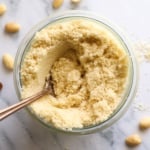
How to Make Almond Flour
Servings: 8
Calories: 167kcal
Here's how to make almond flour at home in just minutes! It's an easy, grain-free flour for low-carb and Paleo baking.
Print Recipe
Add to Collection
Ingredients
- 8 ounces blanched almonds , whole or slivered
Instructions
- Place the blanched almonds in a high-speed blender or food processor, and process until they are finely ground. If using a high-speed blender, be sure not to over-process as the almonds will eventually start to release their oils and become almond butter.
- For best results, do not blend more than 8 ounces of almonds at a time. (I tried using 16 ounces and couldn't get them evenly ground.) For the most finely-ground results, I've found a blender works best, but the flour I made in the food processor also works for making almond flour recipes-- the final product is just slightly grainier.
- For fine almond flour, pour the processed almonds into a fine mesh strainer arranged over a large bowl. Shake the strainer to sift the flour through the mesh. This will catch any large pieces the processing might have missed, leaving you with finely ground flour in the bowl. This flour is ready to use right away in your favorite almond flour recipes.
Notes
Nutrition information is for 1 ounce of almond flour. This is automatically calculated, so it's just an estimate, not a guarantee.
Almond Meal Note: If you don't have blanched almonds, you can use whole almonds and make almond meal instead. This means the flour will have brown flecks in it, due to the skins from the almonds being processed at the same time.
Storage Tips: Store leftover almond flour in an airtight container in a dark pantry, or for optimal shelf life, store it in the fridge or freezer. It must be free from moisture to avoid spoiling.
Nutrition
Calories: 167kcal | Carbohydrates: 5g | Protein: 6g | Fat: 14g | Saturated Fat: 1g | Sodium: 5mg | Potassium: 186mg | Fiber: 2g | Sugar: 1g | Calcium: 67mg | Iron: 0.9mg